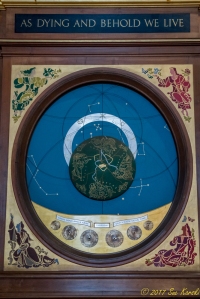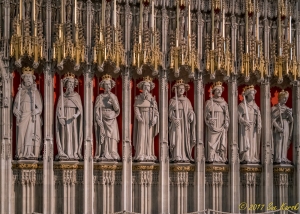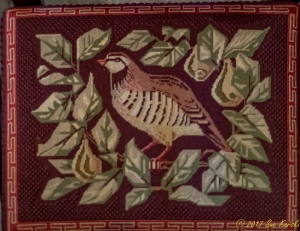Today we took the optional tour to Whitby Abbey and Castle Howard. First stop was the town of Whitby.
Whitby is a seaside town, port and in the Borough of Scarborough and English county of North Yorkshire. It is located on the east coast of Yorkshire at the mouth of the River Esk. It has an established maritime, mineral and tourist heritage. The East Cliff is home to the ruins of Whitby Abbey. The fishing port developed during the Middle Ages for herring and whaling fleets and was where Captain Cook learned seamanship.
Our first stop was on the hillside by the shore so we could see the shore and the abbey on the hillside. It was too hazy to photograph it well at this time of the morning.
Perched high on a cliff, you can see the remains of Whitby Abbey, that were inspiration for Bram Stoker’s gothic tale of ‘Dracula’. Author Bram Stoker stayed in Whitby in the late 1800s, and was so inspired by its ruined abbey and clifftop church he created his most famous character. Dracula arrives in this country after his ship runs aground off Whitby, and runs up the famous 199 steps in the guise of a black dog, and he even took character names from here, making Whitby the ‘Goth’ capital of Britain.
Four hundred years earlier, the abbey was the setting for the artistic awakening of Cædmon, the first named English poet. Cædmon was a layman who had never written a single poem, until one night in a dream he was asked to sing about all creation. To his surprise he found himself singing spontaneous verses in praise of God.
Then we drove around to get up to the Abbey passing a horse with a polka dotted blanket. 
And finally the Whitby Abbey.  and bear came to see the abbey.
and bear came to see the abbey. 


and another pony with a blanket. The wind was blowing up there.


 There were a number of school children there. I caught this one sitting in part of the wall while his teacher was not looking.
There were a number of school children there. I caught this one sitting in part of the wall while his teacher was not looking. 






This spectacular headland was first settled as a monastery in AD 657 by King Oswy of Northumbria. It became one of the most important religious centers in the Anglo-Saxon world under the formidable Abbess Hild. She ruled over both men and women in a double monastery called Streaneshalch.
Centuries of weather and war have taken their toll – parts of the abbey church have collapsed during storms, and its west front was hit by German naval shelling in 1914.
We now were going to walk down those 199 steps to the town.



 In town we learned about Whitby Jet which they polish for jewelry. As we walked along, we saw this man doing a sand sculpture on the sidewalk.
In town we learned about Whitby Jet which they polish for jewelry. As we walked along, we saw this man doing a sand sculpture on the sidewalk.






We went to Trencher’s for Fish and Chips. 
 Notice the potatoes were called Sagitta potatoes. After lunch some walked around town and others stayed close to the center to prepare to head for our next stop.
Notice the potatoes were called Sagitta potatoes. After lunch some walked around town and others stayed close to the center to prepare to head for our next stop.




Some horses just below the ruins of the abbey and on top of the hill.

Now we left to drive to Castle Howard which was close to York, where our hotel is located.
Castle Howard is a magnificent historic house in the north of England, the 18th century residence is set within 1,000 acres of breathtaking landscape just about 15 kilometers outside York.
The Yorkshire stately home boasts world-renowned works or art and stunning architecture having been designed by Sir John Vanbrugh and built with the assistance of Nicholas Hawksmoor.
The grounds include lakes, fountains, temples and woodland as well as formal walled garden and children’s adventure playground.
The Howard family are descended from Lord William Howard the youngest son of Thomas Howard, 4th Duke of Norfolk. The 1st Earl of Carlisle, Charles Howard was the great grandson of Lord William Howard, the youngest son of Thomas Howard. Created Earl of Carlisle in 1661 it was Charles’ grandson, Charles Howard the 3rd Earl of Carlisle, who is famed as the creator of Castle Howard. Although building work began in 1699, the construction of Castle Howard took over 100 years to complete, spanning the lifetimes of three Earls. There was a fire in 1940, and it swept through the building. A number of the artworks and books were saved by the girls of Queen Margaret’s School, Scarborough, who had been evacuated to Castle Howard due to the war and were able to salvage some of the contents.








































 There was definitely lots to see here, including the rose garden.
There was definitely lots to see here, including the rose garden.
Now it was back to our hotel and we had dinner on our own. We found a Polish restaurant not far from our hotel called Barbakan, which was wonderful. We had stuffed cabbage done the old fashioned way.
























 This was a memorial to Normandy invasion and Dunkirk.
This was a memorial to Normandy invasion and Dunkirk. One of the stain glass windows.
One of the stain glass windows.


























































